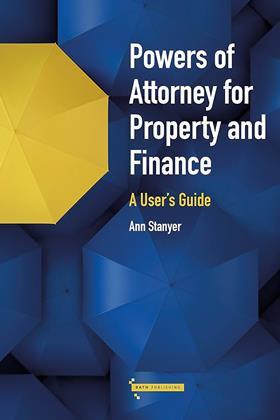Demystifying personal legal planning
Powers of Attorney for Property and Finance: A User’s Guide
Ann Stanyer
£20, Bath Publishing
★★★✩✩
This is an invaluable primer for both legal professionals and the public. Its accessibility and clarity make it an essential read for anyone seeking to understand the nuances of creating and managing powers of attorney (POAs). Stanyer’s work is commendable for its straightforward approach, presenting complex legal concepts in an easily digestible format that is as informative for a seasoned solicitor as it is for a layperson.
One of the book’s strengths lies in its introductory nature, which carefully covers the fundamentals of POAs. Stanyer demystifies the process of appointing attorneys for financial affairs, offering clear guidance that empowers individuals to take proactive steps in their legal planning. The text is particularly beneficial for first seat trainees or those new to the profession, providing a solid foundation upon which to build more specialised knowledge.

While it excels in offering an overview, the book did make my colleague and I want a more in-depth look into specific areas, notably the section on wishes and instructions. It doesn’t really touch on the importance of precise wording to ensure the donor’s intentions are accurately reflected and legally sound. A more detailed exploration of this topic, perhaps with examples of specific wording and how it might impact the effectiveness of a POA, would have been a valuable addition.
The inclusion of questions related to mental capacity assessment stands out as a highlight. Stanyer offers practical ‘break downs’ on how to apply these assessments, providing readers with a clear framework for evaluating a donor’s capacity to grant a POA. This is an area of particular importance, as it addresses the delicate balance between respecting a donor’s autonomy and protecting their interests.
Powers of Attorney for Property and Finance is a resource that demystifies a critical aspect of legal planning. Its accessibility ensures that anyone, from legal professionals to the general public, can gain a comprehensive understanding of POAs. While it serves as an excellent introduction, the depth in certain areas could be enhanced to provide a more thorough guide. Nonetheless, Stanyer’s work is a commendable contribution to legal literature, deserving of a place on the bookshelves of solicitors, attorneys, and anyone interested in the responsible management of personal affairs.
Anna Newport is a solicitor and director at Newport Land & Law, West Yorkshire
Family Financial Arbitration: A Short Guide
Gavin Smith
£15, Class Legal
In this affordable and informative guide, barrister Gavin Smith sets out an explanation of the family arbitration scheme. He lists a total of 11 benefits, including confidentiality, versatility and swiftness, as well as the fact that it offers a choice of arbitrator, and only one drawback: parties must pay for their arbitrator.
The guide is up to date, covering Haley v Haley, the impact of which is that parties can now be confident that, if the arbitrator makes an award which would be appealable if made by a judge, a similar route of challenge is available.
The book can inform practitioners unfamiliar with this form of dispute resolution, or enlighten parties who might be contemplating using the scheme.
Tony Roe is a family law partner and arbitrator at Dexter Montague LLP, Reading































No comments yet